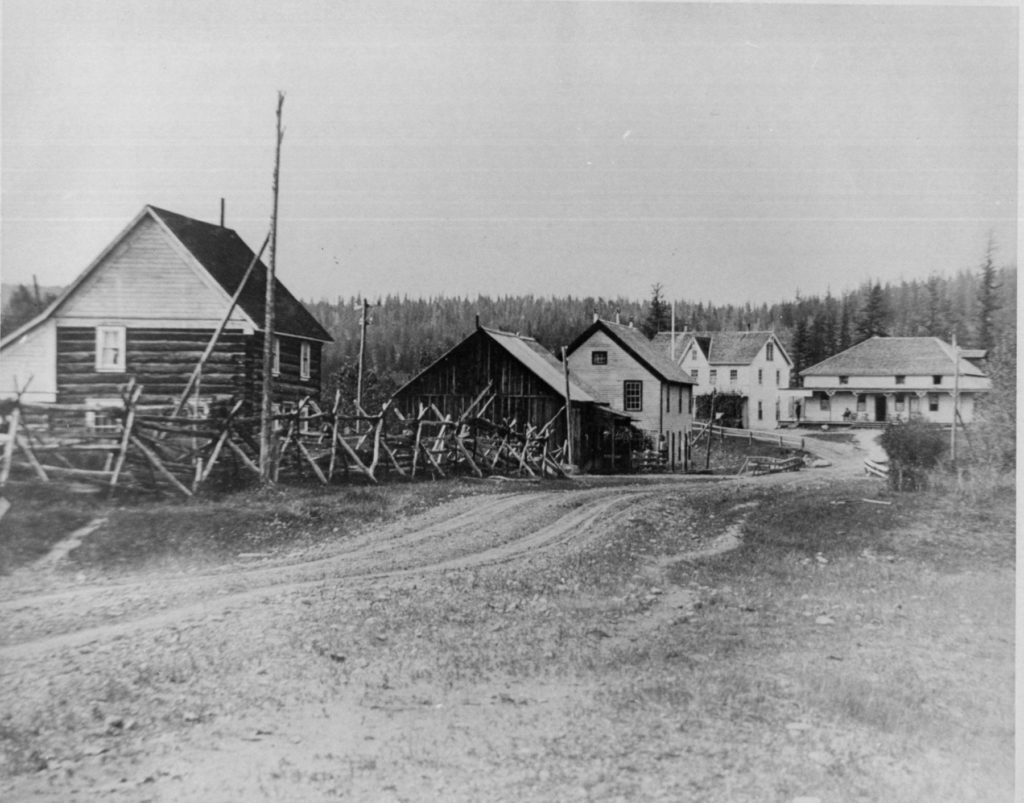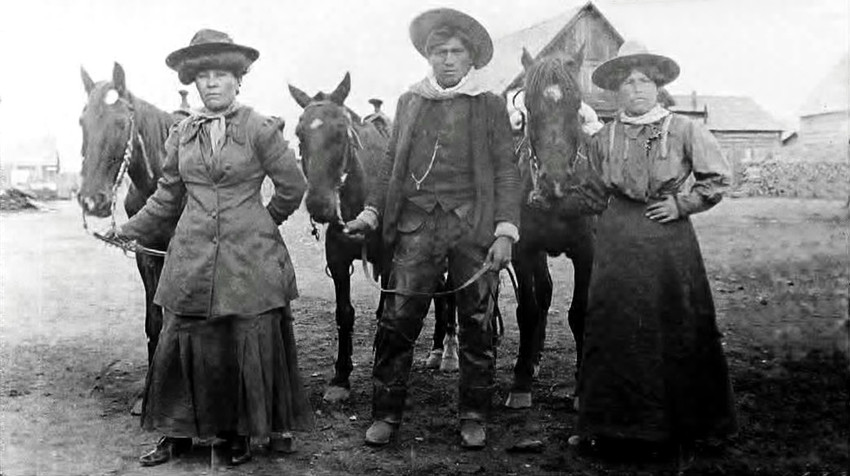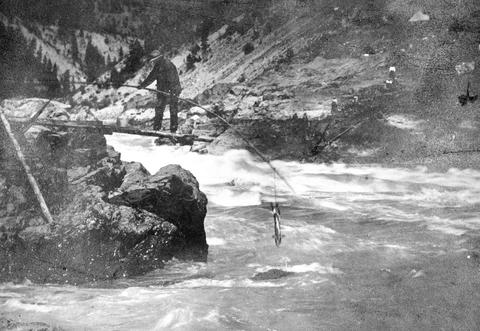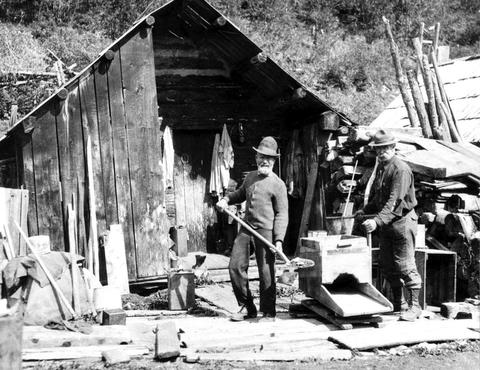British Columbia’s gold rushes forever changed our province
In 1857, gold was discovered in the Fraser River, and in the spring of 1858, James Douglas sent 800 ounces of gold to the San Francisco Mint knowing what word of the gold’s arrival would trigger. There are no secrets in a gold town and rumours of a new gold rush began to spread. By late spring of 1858, prospectors from California, Australia, Mexico, Europe, and as far away as China started to arrive in Victoria and New Westminster.
In April of 1858, within weeks of the first ship arriving in Victoria, thousands made the journey up the Fraser River and into the interior of British Columbia searching for gold. The Indigenous communities that lived in these areas since time immemorial were essential to the survival of the newcomers, trading and providing them with food and goods such as canoes, in addition to acting as trusted guides and translators among other things. As floods of newcomers came to the interior of BC, Douglas did not want history to repeat itself and lose territories to the Americans, so he petitioned Queen Victoria to establish a Colonial Government in New Caledonia. The petition was granted; New Caledonia was renamed British Columbia, and in 1858 it was proclaimed a crown colony at Fort Langley with James Douglas being named the first Governor. Without a doubt, the gold rush shaped the landscape and history of British Columbia forever.
British Columbia’s history is often framed through a European lens; however, it involves a diverse range of people from around the world. The Fraser and Cariboo gold rushes (1858-1867) were no exception. People came from all over the world. Some travelled from Scotland, England, Germany and even from China. Many left their home nations because of political turmoil, violence, discrimination poverty or a lack of opportunities. These people were risk takers and adventurer drawn to the hope of wealth, prosperity, adventure, better living conditions and social freedoms.

VICTORIA SELECTED FOR A HUDSON’S BAY COMPANY POS – 1843
Fort Victoria was a fur trading post of the Hudson’s Bay Company, the headquarters of HBC operations in British Columbia. The fort was the beginnings of a settlement that eventually grew into the modern Victoria, British Columbia, the capital city of British Columbia. The headquarters of HBC operations on the Pacific Coast of North America at the time of Victoria’s founding was Fort Vancouver, on the lower Columbia River, but it had struggled for years to turn a profit; its location was difficult to defend, inaccessible to ships and too far from the lucrative furs in New Caledonia. With American settlers pouring into the region, in 1843, the company sent James Douglas to build a fort some distance north on Vancouver Island and made him its Chief Factor.
California Gold rush – 1848
The first gold rush in North America began in California in 1848 and the California gold rush ended around the mid to late 1850s. The California Gold Rush began when gold was found by James W. Marshall at Sutter’s Mill in Coloma, California. The first to hear confirmed information about gold in California were the residents of Oregon, the Sandwich Islands (Hawaii), western Mexico, and Central America and they were the first to travel to California in late 1848. All told, the news of gold brought some 300,000 people to California from the rest of the United States and abroad. Of the 300,000, approximately half arrived by sea and half came overland from the east, on the California Trail and the Gila River trail. The gold-seekers, called “forty-niners”, often faced substantial hardships on the trip. While most of the newly arrived were Americans, the Gold Rush attracted tens of thousands from Latin America, Europe, Australia, and Asia.
VANCOUVER ISLAND BECAME A BRITISH COLONY – 1849
Constitutional history began in 1849 with the creation by the Imperial Government of a proprietory colony based on a west Indian model, Vancouver Island. On March 11, 1850, Richard Blanshard formally assumed office as Governor of the Colony of Vancouver Island. It was a wintry day, but every effort was made to make the ceremony as impressive as the rudeness of the surroundings at Fort Victoria would permit. A salute of seventeen guns roared out from “H.M.S. Driver” and was answered from the bastion of the fort. All available British residents and a complement of sailors from the “Driver” were assembled in front of the fort to hear the newly-arrived Governor read the Royal Commission, appointing him the first Governor of the first Crown Colony to be established in British territory west of the Great Lakes.
SIR JAMES DOUGLAS WAS APPOINTED THE SECOND GOVERNOR OF THE COLONY OF VANCOUVER ISLAND -1851
Why wasn’t the Cariboo absolute chaos during the gold rush? All the ingredients were there: lots of miners from all over Europe and North America, far from families, governments, and other civilizing influences, desperate for gold. They didn’t have roads or courthouses or post offices when it all started. The Cariboo should have been a dangerous, scary place. There were some fights and murders, but it wasn’t “wild”. Why not? Because of James Douglas (1803-1877), Governor of the colonies of Vancouver Island and British Columbia, known as “the father of British Columbia.” Hard-working, intelligent and well-read, confident and decisive, Douglas was in many ways an ideal governor – though some called him vain and autocratic.
the FRASER RIVER GOLD RUSH – 1858
In the spring of 1858, James Douglas sent 800 ounces of gold to the San Francisco Mint knowing what word of the gold’s arrival would trigger. There are no secrets in a gold town and the supervisor of the mint was also a prominent member of the San Francisco volunteer fire department. Within hours of the next fire department meeting, rumours of a new gold find began to spread. By late spring of 1858, prospectors started to arrive in Victoria and New Westminster. Over the next few months, thousands would travel up the Fraser River and into the Interior, searching for gold. In 1858 Fort Victoria was tiny. No more than 500 immigrants lived on southern Vancouver Island, and these were mainly Hudson’s Bay Company employees, farmers and their families. Within two months the population grew to over 20,000. Almost overnight, Victoria became a tent city as miners camped while they purchased their mining licenses, and all the supplies – equipment, food, clothing, they would need for their journey to the gold fields (Royal BC Museum). After previously losing territories to the American government due to the influx of miners in the California gold rush, Douglas now petitioned Queen Victoria to establish a Colonial Government in New Caledonia. The petition was granted; New Caledonia was renamed British Columbia and was proclaimed a crown colony at Fort Langley later in 1858 with James Douglas being named the first Governor.
B.C. IS ESTABLISHED AS A CROWN COLONY – 1858 to 1866
From 1851 to 1864, he was Governor of the Colony of Vancouver Island. In 1858, he also became the first Governor of the Colony of British Columbia, in order to assert British authority during the Fraser Canyon Gold Rush. He remained governor of both Vancouver Island and British Columbia until his retirement in 1864. He is often credited as “The Father of British Columbia”. By 1857, Americans and British were beginning to respond to rumours of gold in the Thompson River area. Almost overnight, some ten to twenty thousand men moved into the region around present-day Yale, British Columbia, sparking the Fraser Canyon Gold Rush.
The CANYON WAR – 1858
Real tensions existed between miners and the Nlaka’pamux, the First Nations people living in the heart of the Fraser Canyon. The Aboriginal peoples of the Fraser Canyon wanted a negotiated agreement with the miners and the Colony of British Columbia before allowing the miners to enter their territory. The Fraser Canyon was the territory of the Nlaka’pamux nations, who did not want miners to explore up river beyond Yale and into their territory until an access agreement was negotiated. A series of brief battles were fought during the weeks that define the Fraser River War. A number of Aboriginal towns were ransacked and burned; men, women, and children were murdered. The war ended with the arrival of Governor Douglas and the Royal Engineers in Yale.
cARIBOO GOLD RUSH – THE 1860s
Never perhaps, was there so large an immigration in so short space of time into so small place
People came from all over the world. Some travelled from Scotland, England, Germany and even from China. Gold Rush brought immigrants from Hong Kong to the port of Victoria. Chinese miners worked their way up the Fraser River as white miners abandoned these sites. Many Chinese immigrants moved to the Cariboo to become miners or set up businesses such as laundries and restaurants. An estimated 6,000-7,000 Chinese immigrants had come to B.C. There were more Canadian and British prospectors involved in the Cariboo Gold Rush of 1860-63. The commercial centre for the Cariboo rush was Barkerville, named after William Barker, an English seaman who found gold in nearby Williams Creek in 1862. By 1865 the surface placer gold was almost gone. Barkerville was practically wiped out by fire in 1868. In response to the Cariboo Gold Rush, governor James Douglas built, at great expense, a 650-km road from Yale into the rugged interior of the Cariboo Mountains. This provided an important transportation route for further development of the mainland colony.
Yes, Lillooet is know for it’s camels: In the 1860s, some miners came up with the brilliant idea of using camels as pack animals in the canyon. The experiment was not quite a success, but rather than ship the camels back, the miners just let them loose. The last camel roamed the area in 1905.
The OVERLANDERS – 1862
In June of 1862, the Overlanders left Fort Gary (Winnipeg) for the Cariboo goldfields. Included in this group is the famous gold rush artist, William George Richardson Hind and Catherine Schubert was the only woman of this group from Fort Garry.
As with many early miners, Barker’s story began in the American gold fields in the mid-1800s where people from all over the world travelled to seek their fortune. By the mid-1850s, gold finds were slowing and rumours began to surface of ‘easy gold’ on the Fraser River. Barker had worked without much success in California and so he, along with thousands of men, headed north to the British territory that is now British Columbia. In addition to the north-bound travellers, groups later called “The Overlanders” trekked across Canada from the East, and hordes of people were arriving by boat from all over the world to travel up the Gold Trail from the coast towards to Fraser River to find fortune.
Eventually, prospectors made their way to the hills that surround Barkerville and one of the first finds was by William “Dutch Bill” Dietz, for whom William’s Creek (which flows through Barkerville) is named. A small town began to spring up around the area, optimistically named Richfield.
Billy barker strikes gold – 1862
British Columbia’s central interior has been profoundly shaped by gold thanks to a simple, working-class English prospector named William ‘Billy’ Barker who, in 1862, spearheaded a twenty-year, multi-billion dollar industrial revolution that literally helped build a Province.
Barkerville Historic Town & Park
As with many early miners, Barker’s story began in the American gold fields in the mid-1800s where people from all over the world travelled to seek their fortune. By the mid-1850s, gold finds were slowing and rumours began to surface of ‘easy gold’ on the Fraser River. Barker had worked without much success in California and so he, along with thousands of men, headed north to the British territory that is now British Columbia. In addition to the north-bound travellers, groups later called “The Overlanders” trekked across Canada from the East, and hordes of people were arriving by boat from all over the world to travel up the Gold Trail from the coast towards to Fraser River to find fortune.
Eventually, prospectors made their way to the hills that surround Barkerville and one of the first finds was by William “Dutch Bill” Dietz, for whom William’s Creek (which flows through Barkerville) is named. A small town began to spring up around the area, optimistically named Richfield.
Barker eventually ended up in Richfield, trying his hand at a few spots around William’s Creek where his lack of success continued. As time passed, he decided to mine further down the creek, in the area below Richfield. Many people questioned his decision, saying he would find no gold there. But Barker persisted and endured, and was finally proven right on August 17, 1862, when he and his crew ‘struck the lead,’ at a depth of 52 feet.
BARKERVILLE BURNS DOWN
The town of Barkerville burns down in what became known as the Barkerville fire. Though reconstruction began the next day, the Gold Rush was dwindling.
bc joins confederation – 1871
All aboard in British Columbia — After Confederation in 1867, British North America’s West Coast colony of British Columbia (the colony of Vancouver Island had joined it the year before) debated joining the new Dominion. In 1871, when the federal government promised to build a railway connecting the coast to Canada (a promise it kept in 1885), the 12,000 non-native residents of the colony agreed to request its admission to Canada. By a United Kingdom Order in Council, British Columbia became the sixth province on 20 July 1871. Sir Joseph Trutch was appointed the first Lieutenant Governor, and the Legislative Assembly elected John Foster McCreight as the first Premier.
Many cultures were interwoven during this mass migration and to better understand British Columbia’s history you need to examine it from different perspectives.
FemalE Gold Rush Pioneers
Women played an important role in the era of the gold rush. Many female prospectors searched the rivers of BC alongside the men or in partnership with their husbands or family. There were a lack of women that also factored into the gold rush era. During the earlier California and Fraser River Gold Rushes, there were so few women that brides were sent from other parts of the world. An Anglican minister in Lillooet initiated the Columbia Emigration Society to arrange for young women from England to be sent to the Cariboo as potential brides for the miners. The presence of women along the trails was noted in the letters and diaries of male stampeders. In at least one instance, their presence encouraged one man to continue on. In a letter to his wife, Kitty, Fred Dewey wrote, “It is a big day’s work to haul 100 pounds a distance of four miles. There are three women alone on the trail and they are taking their own stuff in. I would be ashamed to back down before difficulties that those women surmount.”
Indigenous people and BC’s Gold Rush

In historical accounts of the gold rushes in BC, Indigenous peoples of the area are overlooked, but they certainly played an important role and were impacted by the mass migrations into their respective territories. Indigenous people provided essentials to prospectors including goods such as canoes and food, and services such as guides and translators. At first, it was documented that both Indigenous people and prospectors benefited from the relationship in regards to trading both goods, services and knowledge. As the quantities of prospectors increased, the competition and rush to find gold, the initial mutually beneficial relationship began to collapse and as time went on Indigenous people were marginalized and terrorized on their own lands impacting their traditional ways of life.

Chinese Prospectors
Chinese perspectives and experiences during the Gold Rush are largely untold, yet the Chinese immigrants’ involvement in the Fraser River and Cariboo gold rushes helped contribute to the British Columbia that we know today.
Before the railway, before British Columbia joined Confederation, many Chinese were already here. They were farming, mining and logging. They arrived by the hundreds starting in 1858 at the start of the gold rush.
Henry Yu
In 1858, the Fraser River Gold Rush brought hopeful immigrants from Hong Kong to the port of Victoria. Chinese miners worked their way up the Fraser River as white miners abandoned their mining sites due to the racism and discrimination. Many Chinese immigrants also moved to the Cariboo to not only become miners, but to become merchants to service the booming gold rush. The first Chinatown in Canada was founded in Victoria in the 1850s, and by the end of the 1860s there were approximately 7,000 Chinese living in British Columbia before and during the Fraser River and Cariboo Gold Rushes.
The first major wave of Chinese immigrants came to BC in 1858. They were looking for ‘Gold Mountain’, or ‘Gum Saan’, a term that was first coined to name the California gold rush. These miners were known in China as ‘Gold Mountain Sojourners’. Like many European and American miners, they were mostly men who planned on staying only long enough to strike it rich, and then return to their homeland with their earnings. But the majority of these miners spent most of their lives overseas with only visits to China. Chinese migrants coming to the BC gold rushes tended to stay in the province longer than other miners, and would often work the same claim of land for a longer period of time than others who travelled from site to site. In many of the areas where gold rushes took place, Chinese and indigenous peoples were targeted by other gold rush migrants, in particular by those who wanted the best sites and opportunities reserved for those considered “‘ white’ miners. The Chinese created their own community support networks based on traditional Chinese societies and clan associations. If a member became sick, was accused of a crime or fell on hard times, these organizations would offer assistance. From these networks, community hubs were formed and Chinatowns emerged in places like New Westminster, Victoria and Barkerville, some of which still stand today (Royal BC Museum).
During the Cariboo gold rush the first Chinese community was established in Canada in Barkerville. Discrimination toward Asians prevented the Chinese from prospecting anywhere other than on abandoned sites, and so they did not make as much money as the white prospectors. Despite this discrimination, the Chinese community thrived by providing many of the required services to the 20,000 prospectors who came into the Barkerville region in the 1860s, including operating grocery stores and restaurants. At the height of the gold rush there were as many as 5,000 Chinese living there (Royal BC Museum).


